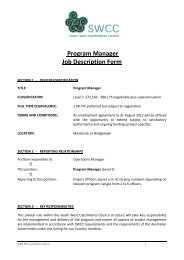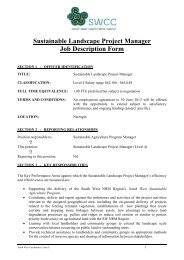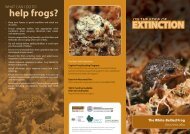Tender for the Programme - South West Catchments Council
Tender for the Programme - South West Catchments Council
Tender for the Programme - South West Catchments Council
Create successful ePaper yourself
Turn your PDF publications into a flip-book with our unique Google optimized e-Paper software.
DRAFT<br />
<strong>South</strong> <strong>West</strong> Regional NRM Strategy – Ancillary Document<br />
<strong>the</strong> probability of persistence of native species increases ra<strong>the</strong>r than decreases in response to climate<br />
change mitigation.<br />
Projected environmental outcomes are known to differ according to whe<strong>the</strong>r power within a governance<br />
framework operates at <strong>the</strong> local, national or international level and <strong>the</strong> relative influence of <strong>the</strong> state or <strong>the</strong><br />
market on society. There has been no previous attempt at climate change mitigation that involves global<br />
carbon markets but lacks global coordination (Su<strong>the</strong>rland et al. 2011).<br />
7.3 Tree decline<br />
The following is excerpted from an unpublished paper “Climate Change and Declining Forest Ecosystems in <strong>South</strong>-west <strong>West</strong>ern<br />
Australia”, by G Hardy, P Barber, B Evans, T Lyons, S Moore, E Veneklaas, P Poot, M Renton, B Dell, T Fleming, R Hobbs, C<br />
Baudains, R Schibeci, M Buizer, L Valentine, T Moore, G Matusick, M Bader, J Chopard, N Brouwers and T Burgess, from State<br />
Centre of Excellence on Climate Change, Woodland and Forest Health, Murdoch University and <strong>the</strong> University of <strong>West</strong>ern Australia.<br />
Accessed on 2/1/2012 from http://www.<strong>for</strong>es<strong>the</strong>alth.com.au/<br />
Tree decline is a serious nationwide phenomenon. A number of woodland and <strong>for</strong>est ecosystems in <strong>the</strong><br />
south-west of <strong>West</strong>ern Australia are suffering from varying degrees of decline. These include Eucalyptus<br />
gomphocephela (tuart), E. wandoo (wandoo), E. rudis (swamp gum), Agonis flexuosa (WA peppermint),<br />
Corymbia calophylla (marri) and E. marginata (jarrah). The causes of <strong>the</strong>se decline syndromes are<br />
complex and it is likely that predisposing (e.g. climate shifts, disturbance regime shifts), inciting (e.g. frost,<br />
drought, insect defoliation) and contributing issues (e.g. soil-borne and canker pathogens, wood and bark<br />
beetles) will be different <strong>for</strong> each of <strong>the</strong>se <strong>for</strong>est or woodland ecosystems. The decline in rainfall and <strong>the</strong><br />
slight increase in average summer and winter temperatures over <strong>the</strong> last 30 years could well be playing a<br />
significant role in helping predispose <strong>the</strong>se ecosystems to decline. These changes toge<strong>the</strong>r with <strong>the</strong> longterm<br />
predictions of a 5-60% decrease in rainfall and a 0.5-6.5 C increase in summer temperatures by<br />
2070 do indicate that our woodland and <strong>for</strong>est ecosystems and <strong>the</strong> ecosystem services <strong>the</strong>y provide are<br />
under threat. Consequently, we need to be thinking about how to manage our <strong>for</strong>ests given that we are<br />
already experiencing climate change and that predictions all indicate substantial change <strong>for</strong> a hotter and<br />
drier climate.<br />
The question now needs to be asked ‘have ecological tipping points been reached <strong>for</strong> any of <strong>the</strong> woodland<br />
and <strong>for</strong>est ecosystems described above’ For example, in areas of <strong>the</strong> tuart <strong>for</strong>est such as immediately<br />
east of Lake Clifton all trees of all age classes are now dead. This is essentially part of an ecosystem that<br />
has collapsed. The consequences of such a decline on ecosystem function and services, and biodiversity<br />
values remain largely unexplored, but are likely profound. Seed banks are no longer present and to return<br />
this area of <strong>for</strong>est to its <strong>for</strong>mer state will require significant management inputs. These would include fire<br />
<strong>for</strong> ash beds, planting of tuart seedlings or <strong>the</strong> manual distribution of seed toge<strong>the</strong>r with A. flexuosa<br />
management to reduce competition. However, we still need to understand <strong>the</strong> causes of tuart decline,<br />
be<strong>for</strong>e we look at active intervention as any attempts to restore <strong>the</strong> <strong>for</strong>est might well be unsuccessful. In<br />
<strong>the</strong> case of marri, <strong>the</strong> canker fungi Quambalaria coyrecup (<strong>the</strong> cause of branch, stem and trunk cankers)<br />
and Q. piterika (<strong>the</strong> cause of foliar, flower and fruit blight) are now wide spread and causing profound<br />
decline and death of marri across most of its range. Q. coyrecup is believed to be an endemic pathogen,<br />
so why is it now expressing itself as a primary pathogen This could be due to a change in <strong>the</strong> virulence of<br />
<strong>the</strong> pathogen, or to drought or some o<strong>the</strong>r change in <strong>the</strong> abiotic environment that has shifted <strong>the</strong> ability of<br />
marri to defend itself from <strong>the</strong> pathogen. There<strong>for</strong>e, <strong>for</strong> marri unlike <strong>for</strong> tuart, we have a much clearer<br />
understanding of <strong>the</strong> cause of <strong>the</strong> declines, although we do not know why marri, which has likely evolved<br />
with Q. coyrecup is now unable to defend itself. O<strong>the</strong>r similar stories and questions can be linked to <strong>the</strong><br />
o<strong>the</strong>r woodland and <strong>for</strong>est ecosystems that are in decline. The most effective way to address <strong>the</strong>se will be<br />
to develop multi-disciplinary research teams that interact and work closely with stakeholders.<br />
Many knowledge gaps still exist with regards to climate change and <strong>for</strong>est health:<br />
Tree water use - how much does a particular tree species need <strong>for</strong> survival and what level of a lack of<br />
sufficient water causes a tree to become stressed<br />
207






